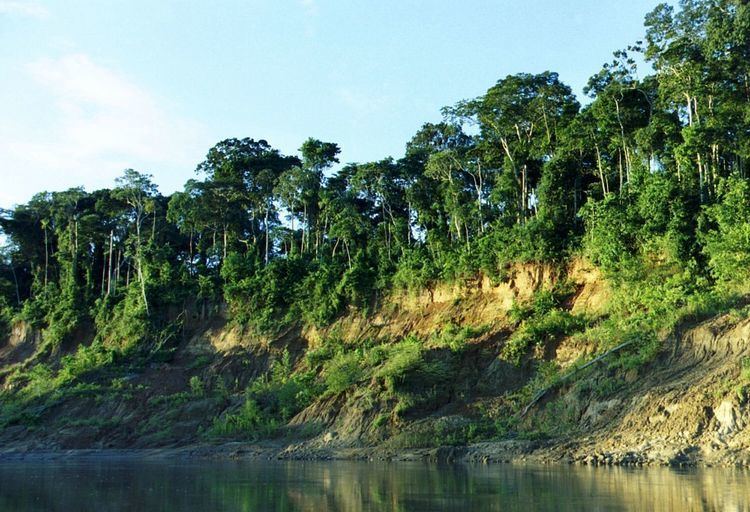Nearest city Cusco Type Natural | Governing body SERNANP | |
 | ||
Location Madre de Dios Region, Cusco Region, Peru Area 1,716,295 ha (6,626.65 sq mi) Established May 29, 1973 (by 644-73-AG) | ||
Manú National Park (Spanish: Parque Nacional del Manu) is a biosphere reserve located in Madre de Dios and Paucartambo, Cusco. Before becoming an area protected by the Peruvian government, the Manú National Park was conserved thanks to its inaccessibility. The park remains fairly inaccessible by road to this day. In 1977, UNESCO recognised it as a Biosphere Reserve and in 1987, it was pronounced a World Heritage Site. It is the largest National Park in Peru, covering an area of 15,328 km². The Biosphere Reserve includes an additional 2,570 km², and a further 914 km² are included in a "Cultural Zone" (which also is afforded a level of protection), bringing the total area up to 18,811 km².
Contents
The park protects several ecological zones ranging from as low as 150 meters above sea level in parts of the Southwest Amazon moist forests to Peruvian Yungas at middle elevations to Central Andean wet puna at altitudes of 4200 meters. Because of this topographical range, it has one of highest levels of biodiversity of any park in the world. Overall, more than 15,000 species of plants are found in Manú, and up to 250 varieties of trees have been found in a single hectare. The reserve is a destination for birdwatchers from all over the world, as it is home to over 1000 species of birds, more than the number of bird species found in the United States and Canada combined and almost 10% of the world's total bird species. It is also acclaimed as having one of the highest abundances of land vertebrates ever found in Latin American tropical forests.
Park layout
The park encompasses virtually the entire watershed of the Manú River, from the sources of its tributaries high in the Andes, to its emptying into the Madre de Dios River. As the surrounding area is largely undeveloped, the only direct access to the lowlands is by boat, up the Manú River. This singular entry point is easily patrolled by park guards. The road Cusco-Paucartambo-Shintuya borders the southern section of the park and provides access to high-Andean ecosystems, such as grasslands (puna) and montane forest and scrub.
Park administration
As with all national parks in Peru, Manú is operated by INRENA, the National Natural Resources Institute (Instituto Nacional de Recursos Naturales).
Humans in the park
Permanent human habitation is restricted to several small communities of the Matsigenga Amazonian tribal nation, largely along the Manú river or one of its main tributaries. Several protected areas adjoining the park allow mixed use including tourism, hunting, logging, and harvesting of other resources. These areas, notably downstream on the Manú River, are included in the broader Manú biosphere reserve, but are not part of the national park.
Visitors within the national park include medical and educational professionals upon invitation by the indigenous community, and researchers with permits from INRENA. The Cocha Cashu Biological Station, under the guidance of renowned Duke University ecologist John Terborgh is the largest and most established research site in the park, and is among the most well-studied sites for biological and ecological research in the tropics.
The Manu Learning Centre (MLC) lies within the Cultural Zone of the Manu Biosphere Reserve along the South-Eastern border with the Alto Madre de Dios River. The MLC facilitates research work within the disturbed 'buffer' zone of the park where human impact is at its greatest.
Flora
More than 20,000 species. 40% of the park is Amazonian lowland tropical rainforest, including varzea, oxbow lakes, Mauritia palm swamps, and upland forest types.
Fauna
The Manú Biosphere Reserve has a very rich wildlife. Larger species of the lowland forests include the Peruvian jaguar, puma, ocelot, giant otter, giant anteater, southern tamandua, giant armadillo, nine-banded armadillo, brown-throated sloth, Hoffmann's two-toed sloth, Brazilian tapir, capybara, pacarana, lowland paca, collared peccary, white-lipped peccary and several deer species, like South American red brocket, and South American brown brocket. The marsh deer, actually rather a savannna animal, has also been confirmed. There are 14 species of monkeys. These are Goeldi's marmoset, pygmy marmoset, shock-headed capuchin (Cebus albifrons cuscinus), tufted capuchin (Cebus apella peruanus), brown-mantled tamarin, emperor tamarin, moustached tamarin, black-capped squirrel monkey, black-headed night monkey, brown titi, Rio Tapajós saki, Bolivian red howler, Peruvian spider monkey, and gray woolly monkey. Confined to the mountainous areas above ca. 2,000 m are Peruvian white-tailed deer, dwarf brocket, culpeo, mountain paca and spectacled bear. The puma also reaches very high elevations of up to 3,450 m.
